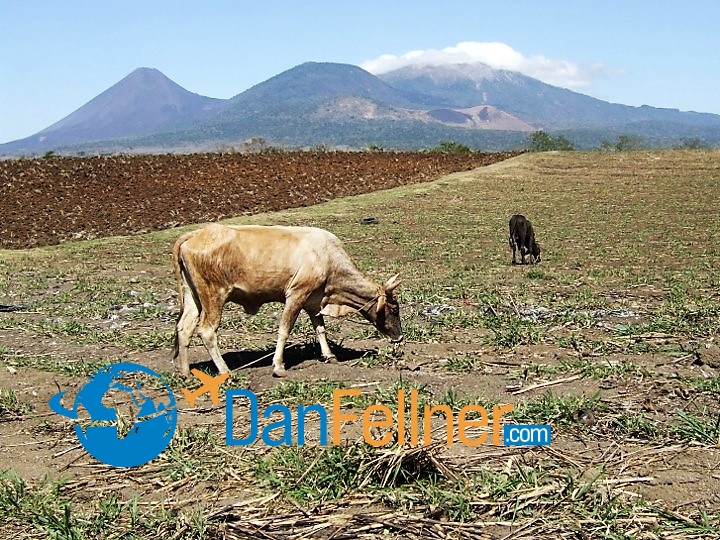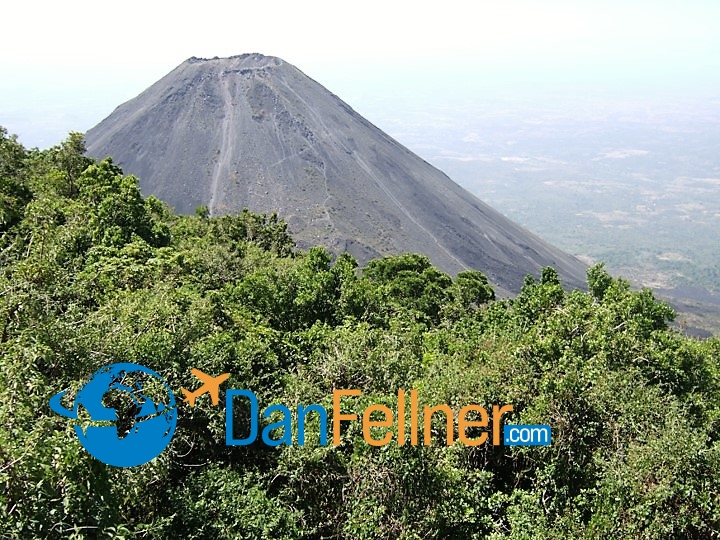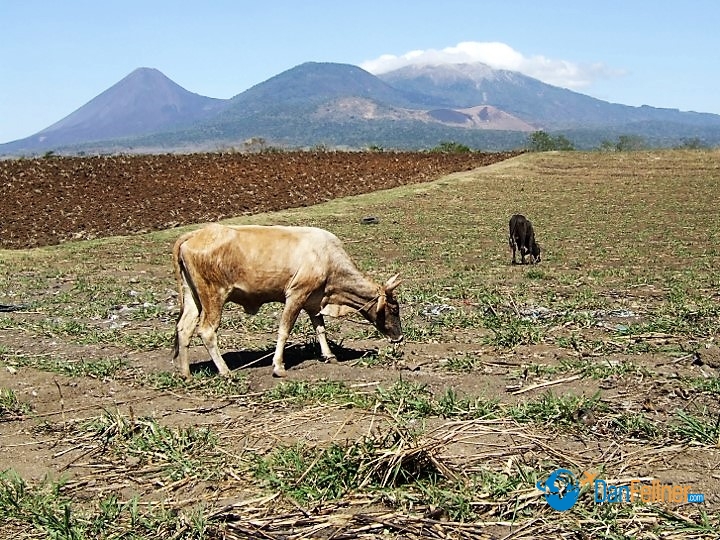Central American country not for inexperienced travelers
International Travel News — January, 2011
SAN SALVADOR, El Salvador- It was my third day in San Salvador and I had yet to encounter another tourist.

The view of San Salvador Volcano from one of the city’s many shopping malls.
I struck up a conversation with the manager of the hotel at which I was staying, the Novo Apart-Hotel, an apartment-style complex in a fairly nice part of town with a swimming pool and great view of the San Salvador Volcano.
She was one of the very few people in the country I had met who spoke English. I asked her if I was the only North American tourist staying in the hotel that week.
“No,” she told me, there was also a couple from Canada, which made a grand total of three tourists. “For us, that’s a lot,” she said.

An upscale shopping mall in San Salvador.
If you like to visit a destination that offers good weather, beautiful countryside, plenty of shopping, and some of the best surfing in the world — and don’t like rubbing elbows with other tourists — El Salvador is hard to beat.
But it’s not a place to go if you want a relaxing, hassle-free, pampered trip. El Salvador doesn’t have much of a tourism infrastructure and few people speak English. Crime is also a problem; the country has one of the highest homicide rates in the world.
The only danger I encountered, though, was dodging speeding cars when venturing from the hotel on foot. With aggressive drivers and few crosswalks and stoplights, San Salvador is not a pedestrian-friendly city.
I find walking is the best way to explore a city but never felt comfortable walking in Sal Salvador. It wasn’t because of crime, but because of cars. When crossing a street, I would usually sprint because I never knew when a car would come zipping around the corner.
El Salvador is the smallest country in Central America but with more than 6.5 million people, it is the most densely populated. About one-third of the country’s residents live in San Salvador, which is located in a valley at the foot of the massive San Salvador Volcano.
The city has been hit hard over the years by earthquakes — most recently in 2001 — which is why you won’t find many historic buildings. But you will find some of the biggest shopping malls in Central America. It seemed like there was a mall every few blocks full of upscale stores and American fast-food joints.

The San Salvador home of Archbishop Oscar Romero, who was murdered in 1980. His assassination triggered a 12-year civil war in El Salvador.
A good place to learn about the country’s recent violent history is the small church where Archbishop Oscar Romero was murdered in 1980. Romero’s assassination helped trigger a 12-year civil war that killed more than 75,000 Salvadorans and caused hundreds of thousands of people to flee the country.
Romero, who had been critical of the country’s government, was shot by a right-wing death squad while conducting Mass. Near the church is the home where Romero lived. It’s been converted into a small museum and displays the blood-soaked robe he was wearing when he died.

Paintings of Archbishop Oscar Romero inside the garage of his home in San Salvador. Romero was murdered in 1980.
I happened to be in El Salvador three weeks before a presidential election. Political banners and billboards promoting candidates for the two leading parties — the leftist FMLN and the conservative Arena party, which had won the last four presidential elections — lined the roadways.
Mauricio Funes, a television journalist who was recruited to run for president, won a narrow victory for the FMLN, giving the former rebel movement its first taste of power.

Cows graze near Cerro Verde National Park in El Salvador.
El Salvador’s most interesting sites aren’t man-made, and they aren’t in San Salvador. About an hour’s drive northwest of the city is the Cerro Verde National Park, where hikers can climb dormant volcanoes and see breathtaking vistas of the surrounding countryside below.
The most dramatic volcano in the park is the black-coned Izalco. It last erupted in 1966, but if you look closely, you can still see small wisps of smoke emerging from the cone.

A close-up view of the black-coned Izalco Volcano. It last erupted in 1966.
There are several hiking trails in Cerro Verde and it’s best to spend a few dollars to hire a guide to show you the way and point out the various species of birds and flora in the area. I visited the park on a Tuesday and saw only one other car in the parking lot.
From Cerro Verde you can see the vividly-blue Lago Coatepeque, a volcanic crater lake. It’s a popular weekend get-away for Salvadorans, who come for fishing, boating, hiking and swimming. There is a small island on the lake called Teopan, which has accommodations and a bird sanctuary.
Also visible from viewpoints on Cerro Verde is El Salvador’s Pacific coast, known for quiet beaches and outstanding surfing. A number of tour operators now offer surfing trips to take advantage of the consistently good waves. Interestingly, El Salvador is the only country in Central America without a Caribbean shoreline.

Lake Coatepeque in western El Salvador.
Because so few tourists visit El Salvador, it’s difficult to find organized tours at reasonable prices. I called several tour companies to see if they offered excursions of San Salvador or the volcanoes. They did, but because no one else had signed up on the days I wanted to go, the price would have been prohibitive to go alone. One company wanted $200 to take me on a tour of the countryside.
With the help of the hotel manager, I ended up hiring a taxi to drive me to the volcanoes and Lake Coatepeque. It cost $60 for a five-hour trip.
Problem was, the driver didn’t speak English and with my limited Spanish, we had a difficult time communicating. But it’s amazing how with a few select words (for instance, “alto” when I wanted him to stop so I could take a picture) and gestures, we were able to get by. It turned out to be a very enjoyable day and I hired the same driver to take me to the airport the next morning, which cost $25 for the 45-minute trip.

Salvadoran children outside a rural school.
I was surprised at how relatively pricey El Salvador was, especially compared to Nicaragua, from where I had arrived. Restaurant prices were about the same as in the United States and taxis and hotels cost considerably more than in Nicaragua. There were also a lot more tourists in Nicaragua, which meant it was easier to find low-cost tours and English-speaking guides there.
One factor in El Salvador’s favor is that it adopted the U.S. dollar as its official currency in 2001. Therefore, American tourists don’t have to worry about changing money and exchange rates. Bring small bills, though, as many stores won’t take anything bigger than a $20 bill.
But El Salvador’s biggest plus is a feeling that you’re seeing the unspoiled natural wonders of a pretty country that not many other tourists have experienced.
Just be sure to brush up on your Spanish before you go, and look both ways and walk quickly when crossing the street.

El Salvador’s coat of arms.
© 2009 Dan Fellner


2 Comments
Tania Garcia
This is really helpful, I would really like to go to El Salvador to visit my family, but have an overview of how it is there is nice. Ive heard lots of great things about my heritage, and now I can’t wait to go.
Dan
Thank you for the comment, Tania. Hope your trip to El Salvador soon becomes a reality.
Comments are Closed.